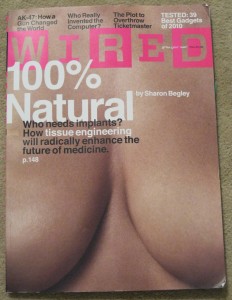Stem Cells, Breast Reconstruction and a Magazine Cover
The cover of the November print edition of Wired features large, unnatural-appearing cleavage. Inside and toward the back of the issue, a curious article ties together stem cells and the future of breast reconstruction. It got my attention.

The detailed and admittedly interesting piece, by Sharon Begley, describes what’s science or science fiction: first humans, such as some plastic surgeons, remove adipose tissue, a.k.a. fat, by a well-established cosmetic surgery procedure called liposuction, from a body part where there’s a fat surplus – such as the belly or backside; next, laboratory workers purify and grow what are said to be stem cells from that that fat; finally, they use a nifty, calibrated and expensive device to inject those fatty stem cells where women want, such as in a hole or dimpled breast where a tumor’s been removed.
The story starts, unfortunately and distractingly, with a portrait of a male, enterprising and PowerPoint presentation-giving CEO of a biotech company, Cytori Therapeutics. Toward the end of the article, the author provides stats to support the potential business. Ultimately, improved breast cancer survival means that greater numbers of women will live more years after a lumpectomy or mastectomy, she explains. The reconstruction market may expand further, still, because some women opt for prophylactic mastectomies upon positive genetic testing for a BRCA mutation. Others, without cancer or high risk, might simply want to use these adipose-derived stem cells for cosmetic breast augmentation. What’s clear, if nothing else, is that women’s breasts are perceived as a commodity.
In between the money elements of the discussion, there’s some cool science about adipose-derived stem cells, which according to the cited scientists are quite prevalent in fatty tissue and relatively easy to grow if you give them some blood to feed on in the lab. A putative advantage of the cells is that they draw blood vessels to the area of engraftment, which is a concern to this oncologist (me) and, evidently, to an FDA panel that has not yet approved of this innovative method of breast reconstruction in women who’ve had breast tumors.
I’m not convinced, at least from what’s reported in this Wired article, that the cells used in this process are true stem cells, based on the high numbers the scientists describe finding so readily, and in rich proportions, in human fat tissues. It could be, for example, that what they’re isolating are really primitive adipose cells that can, indeed blend into the breast tissue and even recruit blood vessels as described, but aren’t true, pluripotent stem cells – the kind that can form any kind of blood cell or heart cell or neuron. Perhaps stem cells just sound sexy, at least to investors.
Now there are two reports out of the Univesity of Pittsburgh that show adipose-derived stem cells added to breast cancer cells in the lab can promote rapid growth of the cancer cells. So what might this mean for a woman seeking cosmetic breast augmentation by fat injection enhanced with stem cells who also has an early, undetected breast cancer?
You can read more about this at
http://www.asianplasticsurgeryguide.com/news10-2/111003_stem-cells-breast-cancer.html